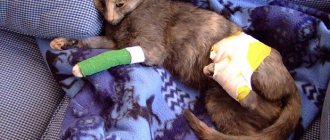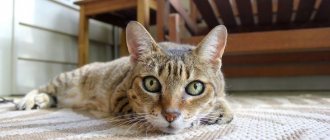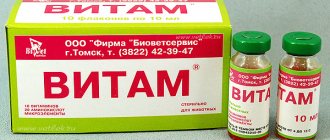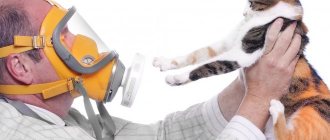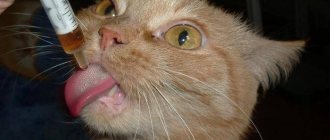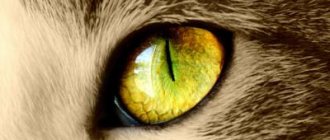6142Administration
Everyone knows that a cat's tail is a kind of indicator of the mood of a four-legged pet. A dissatisfied, excited or angry cat signals its feelings by twitching this part of its body. The tail is also necessary for coordinating cat movements. In some cases, you can observe a crooked tail in cats. This phenomenon is much more common in cats than in dogs. What does this feature mean? What causes a crease to form and is it dangerous to the cat’s health?
Congenital tail defects
We are talking about a structural feature of the tail, which occurs quite often in newborn kittens. According to statistics, some cat breeds are especially susceptible to congenital tail defects (for example, Burmese or Scottish fold cats).
In itself, such a hall is not scary and does not in any way threaten the life or health of the pet. You just have to remember that if a cat has a broken tail, the path to exhibitions and competitions among its own kind will be closed. Such an individual is considered to be out of condition, that is, not suitable in terms of body structure parameters. So an animal with a congenital crease will delight the eye and heart exclusively at home. You will have to forget about the career of a “cat model”.
Another important factor is the ability of cats to pass on the peculiarity of their tail structure by inheritance. In other words, future kittens have every chance of repeating the fate of the “crooked-tailed” parent. Moreover, this anomaly may worsen, and the offspring may develop complications in the form of spinal disorders, coordination of movements and many other troubles. This is why an animal with a crooked tail is not suitable for breeding. The best way out of the situation would be castration or sterilization.
Causes of tail damage
Most often, damage to this part of the body is caused by external factors. Why a cat may have an injured tail:
- got their tail caught in a door;
- from bites of other animals;
- stepped on the tail;
- the pet was spanked severely as punishment;
- due to an accident;
- from applying a large impact on this part of the body;
- other factors affecting the lower back or tail of the animal.
Fracture as a result of injury
Often a crease in the tail appears as a result of injury..
Blows, bites, falls from a height, a tail pinched by a door - this is not a complete list of reasons for a cat's tail to be bent. Unfortunately, the owner does not always pay due attention to this fact, and even less often a splint, plaster, or at least a pressure bandage is applied to the damaged area. The cat continues to live with a damaged tail. The injury heals slowly and poorly, resulting in an improperly healed injury. This is what provokes the appearance of a crease.
© shutterstock
Head injuries or diseases of the nervous system suffered by the cat are considered even more dangerous. In such cases, pinching of the bundle of nerves in the caudal region and damage to the spinal cord may occur. In such cases, the pet's tail may take on an atypical shape.
Sometimes, after an injury, a crease in the tail appears and at the same time, the animal exhibits strangeness in its gait. If a crooked tail is accompanied by disturbances in motor activity or the cat begins to have difficulty oriented in space, this is a serious reason to contact a veterinarian.
Signs of a fracture
The signs of a broken tail are so noticeable that you will spot them right away. The first thing you need to pay attention to is a pronounced visual fracture of the tail. This will be immediately noticeable, so you can quickly respond and seek help from a veterinary clinic in Moscow.
Other signs indicating a tail fracture:
- strong pain,
- increase in body temperature,
- tail inflammation,
- lack of muscle support (the pet’s tail just hangs down),
- paralysis,
- numbness of the tail,
- urinary incontinence,
- the pet's inability to go to the toilet on its own.
These symptoms are characteristic of a tail fracture. However, a serious condition will be accompanied by other (general) symptoms. These include worsening appetite, general malaise and weakness, refusal to play, and lethargy.
When a fracture occurs, the pet drags its tail and cannot control it. This condition is called “dead tail”. It often leads to a decrease or complete loss of sensitivity in the hind legs. All this disrupts the coordination and balance of the animal’s movements.
If you see that your cat's tail is broken, then do not hesitate - contact your veterinarian ! This will quickly relieve pain and avoid possible dangerous consequences.
Host actions
What should an owner do if he discovers that his pet has a broken tail tip, base or middle part? The procedure depends largely on the duration of the injury :
- Old kink . Sometimes the fact of injury goes unnoticed by the owner and the tail gradually heals on its own. In this case, if nothing bothers the pet, no measures need to be taken.
- "Fresh" injury . The situation is completely different if the cat’s tail injury occurred just recently and was quite serious.
Putrefactive bacteria can enter the wound, after which suppuration and foul-smelling discharge will begin.
Therefore, if the cat has suffered a tail injury (of any severity), you should not start this process. The pet needs to be taken to the veterinarian urgently. Typically, a tail injury can be corrected with a tight bandage or cast. In extremely severe cases, the tail may be amputated above the fracture site.
Diagnosis at the veterinarian
The diagnosis can be made during the initial examination, since a fracture or other serious injury to the tail will be immediately noticeable. The doctor’s main task is to determine which part of the tail was damaged.
To do this you will need:
- visual inspection,
- owner survey,
- radiographic examination,
- blood and urine tests.
All this will allow you to find out how serious the damage is and what treatment the animal will need.
Treatment: methods and effectiveness
The treatment for an injury depends on the extent of the damage and the location of the wound. If the fracture is diagnosed closer to the tip of the tail, then no major surgical intervention will be required.
If an open fracture is diagnosed, treatment will take longer. It involves removing bone fragments and severe bleeding. It requires immediate stopping, as it poses a threat to the health and life of the pet.
To remove fragments and examine the destroyed vertebrae, drugs for local anesthesia are used. This will ensure the safety of the animal and prevent possible discomfort during the intervention.
To prevent infection from entering the body through damage, the doctor will prescribe a course of antibacterial therapy.
Gypsum
Typically, for fractures and severe dislocations of the caudal vertebrae, plaster is prescribed. An alternative to plaster is applying a fixing bandage. Plaster is not very convenient for a pet, so it is used in rare cases. Most often, veterinary clinics use fixing bandages applied directly to the pet’s tail.
After applying a cast or bandage, you will need to use a special collar. On average, the duration of such treatment is about 21 days. In especially severe cases, the period of wearing the fixing bandage is increased. A mandatory requirement is to monitor healing using x-rays.
Amputation
This is a radical treatment method, used quite rarely. It is used only for special indications, which include tail paralysis or an open fracture at the very base of the tail. The surgery is performed under full anesthesia, so your pet will not feel pain or discomfort.
After amputation, quite a long rehabilitation will be required, taking from 14 to 20 days. Possible consequences of injury include the inability to go to the toilet on your own. In this case, the owner will need to manually massage the bladder and help the pet empty its bowels.
Drug therapy
It is not used as an independent treatment, but is prescribed separately (in addition to plaster or amputation). Drug therapy involves taking a number of medications necessary to restore the pet’s body and strengthen it. If necessary, vitamin and mineral complexes are prescribed.
Remember that only a doctor can prescribe effective treatment. Do not risk the health of your beloved pet - entrust its treatment to specialists.
Biology of wound healing
Wound healing is a normal physiological function, the essence of which is to restore tissue integrity after injury. This is a complex process characterized by macroscopic, microscopic and biochemical processes. Significant advances in molecular technology have increased our understanding of these processes. Based on this knowledge, the doctor can make decisions about future treatment options and adjust the wound healing process.
Wound healing is described in phases (hemostasis, inflammation, cell repair, maturation) based on microscopic change. These phases have corresponding macroscopic changes that can be observed by the doctor.
Postoperative care for animals after tail amputation
On average, the recovery period for physically strong cats is 10-14 days. For recovery it is necessary to create comfortable conditions:
- isolate from other animals and young children to avoid causing additional injuries;
- place bowls of water and food next to the patient’s bed so that the patient is comfortable;
- put on the operated patient a special collar that prevents teeth from licking and injuring the healing appendix;
- help your pet when it is difficult to discharge small and large needs (massage, support over the tray);
- follow the instructions of the attending physician: wash and bandage the stump, give the pet prescribed medications, including antibiotics to eliminate the inflammatory process and painkillers.
What problems might arise?
Among the pathologies associated with the tail, injuries come first. Mechanical damage leads to fractures and dislocations. Most often they occur at home. Owners go to the veterinary clinic with a complaint that they accidentally pinched the tail in a door or stepped on it. Often, children who like to pull the cat’s tail act as a traumatic factor.
Tail injuries in appearance immediately attract the owner's attention. The tail may become swollen and noticeably kinked, and when you try to feel it, the cat will begin to experience severe pain.
Damage in this area should not be ignored, as for cats they are very painful and cause severe discomfort. The most dangerous injuries are located closer to the sacrum. Inflammation can affect the nerves that control normal urination and function of the hind legs. If the nerves have been damaged due to injury, recovery may take up to six months.
In most cases, as a result of timely first aid and proper treatment, injuries resolve without complications with complete restoration of the tail. Fractures located closer to the end, in the area of the last caudal vertebrae, heal especially well. In stray cats, such injuries occur independently without outside help. The broken tip ceases to supply blood, gradually dies and falls off.
In any case, it is advisable to take an x-ray to see what condition the tail bones are in.
Why does a cat need a tail?
Why does a cat need a tail and what is its function? In addition to decoration, it performs the following functions:
- coordination of movements during jumps (helps the fidget land smoothly);
- maintaining balance when moving along narrow and unstable surfaces;
- communication (this or that movement makes it clear the psychological mood).
The tail helps the cat maintain balance
Tail like a passport
An exception to the “black list” are bob-tailed cat breeds; for them, deformation is the norm prescribed by the standard. In the animal world they are known as Mekong or Thai bobtails. In representatives of this breed, each tail is unique and has only its own inherent loops, kinks and bends. Not all of them are noticeable under the fur, but when palpated, the sign of the breed becomes obvious.
Each breed of animal is determined by specific features in appearance and character traits that are unique to it - this is called the breed standard, which must be recognized by various organizations of felinologists (TICA, FIFe, WCF, CFA, IFA, ICU, WACC, etc.) for each of them own rules of recognition. All purebred cats are given pedigrees.
